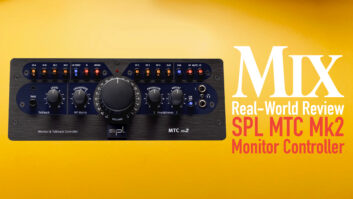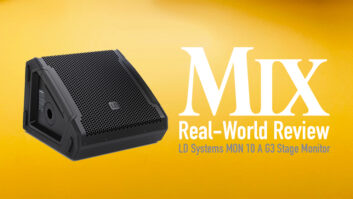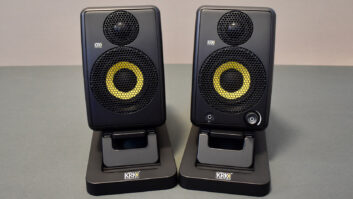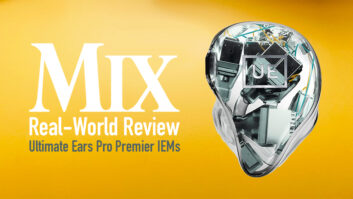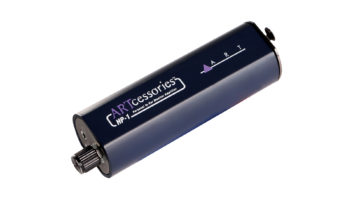The Killers’ FOH engineer Kenny Kaiser says using IEMs at festivals helps keep everything consistent for the band as they tour.
It’s arguable that wireless in-ear monitor (IEM) technology has improved live music performances, thus festival audio production, in more ways than any other gear-based trend over the past two decades—and that’s saying something, as digital mixers, digitally-controlled line arrays and networking/system control technologies have progressed by leaps and bounds within the same time period.

From an IEM’s accuracy and consistency compared to traditional “wedge” stage monitors to the literal freedom gained by touring artists on wireless monitoring rigs, hearing on stage has never been easier. And, from a front-of-house perspective, mixes have never been cleaner, or had the potential to be more “like the record,” in live sound history. All this can be attributed to the massive impression that tiny ear buds and associated wireless monitoring technologies have made on the touring market.
“I’ve seen quite a shift to in-ear monitoring over the past 15 years,” offers Cory Lorentz, Shure’s Artist Relations manager, who has witnessed his company’s early innovation in wireless IEM technology first-hand. “I believe a lot of artists are willing to try it today because the technology has advanced so much. It sounds better [than traditional monitor/wedge applications], it’s more comfortable, it’s safer and it allows artists to feel more in control. The control aspect of wireless IEM use is basically the ability for artists to adjust, at the very least, their own monitoring levels with the gained freedom to move around.”
“It comes down to reliability and audio quality,” adds Lorentz’s Shure colleague Nick Wood, product manager for Axient and Wireless Workbench product lines. “Those are our core values in the midst of a lot of technological change.”
TO WEDGE, OR NOT TO WEDGE
Kenny Kaiser, front-of-house engineer for international superstar band The Killers, who headlined a few festivals this summer including the Outside Lands Music & Arts Festival in San Francisco, finds himself splitting the difference between enjoying IEM use and providing the classic comforts of monitor wedges on stage—a practice of many FOH engineers. “For this last world tour, we’ve had a hybrid setup,” he
explains. “Some of the band is on IEMs while others are only on wedges. For IEMs, we’re using Shure PSM 1000 wireless systems with Ultimate Ears ear molds for most of the band and the crew. For wedges, we have a total of 12 d&b audiotechnik M2 wedges, one L-Acoustics dV-SUB for drums, and 12—six per side—of d&b audiotechnik Q1 for side-fill. At front-of-house, I am using a Lectrosonics R400a digital hybrid system for my SMAART rig, and I love it: it’s bullet-proof and I don’t have to pack 300 feet of XLR any more to tune PA on a daily basis.”
“None of this is scientific fact, but I go to shows and ask, ‘why no wedges?’ and the answers shared are what ultimately gets IEMs onto major stages,” explains Lorentz. “Some bands may be fine with wedges, but for most touring acts, that lack of consistency will take away from performances and confidence, from show to show, especially for festival performances. After all, one night you’re using some QSCs and then the next night you’re on d&b—both very good products, but different. This is where in-ears really come in handy; they provide the comfort of consistency.”
“There are some folks that really like wedges,” continues Lorentz. “It’s the rock and roll thing, and I get it. I’ve been on those stages and it’s loud. There’s something to be said about that experience, but more artists seem to care about hearing conservation these days, too. They don’t want tinnitus.”
“I think the whole ‘wedge monitors vs. IEM monitors’ debate really depends on the band and the sound they are going for,” concludes Kaiser. “Bands like Muse are all on IEMs; their amps are off-stage to get that ‘studio’ mix, and this really works for them. That band has such a clean sound; having wedges on the floor would just make things harder in accomplishing that. Meanwhile, the Foo Fighters are a wedge band and that works for them. The Foos are a big, loud rock band and the wedges add that ‘live’ element to their music. The Killers do a little bit of both, which I think is a great fit. Because they are a band with a lot of keyboards and effects, IEMs help a lot with stage noise. Having wedges, and adding what needs to be added for the members that are on wedges, brings just a bit of a ‘club’ vibe to the overall sound at front-of-house.”
WHY FOH ENGINEERS LOVE WIRELESS IEMS
Rather than mixing “around” massive stage volumes exacerbated by rows of wedges and side-fill, front-of-house engineers enjoy cleaner signals thanks to wireless IEM use. “It makes the front-of-house job more about mixing and less about reinforcement, so my nights are easier, too,” explains Kaiser. “The Killers go from playing arenas to Wembley stadium, and, just last week, to a small 100-seat club in San Francisco. As the act moves closer to ‘all-IEM,’ I avoid extra noise coming off the deck from both amps and monitors. With monitors, every building and every mobile stage sounds different. Because of that, set up and changeovers take longer; this is especially a problem in festival settings. At front-of-house, I must deal with the monitor guy pushing more instruments in the wedges to make the artist happy. Yet, with IEMs, you can put guitar and bass amps anywhere; they don’t have to sit on stage, facing the people on the floor. They can be off the stage, in the wings, and the band can still get the mix they want every night.”
“[With festival-based wireless IEM use], you’re not running cables, extra amps and a completely different setup from one band to the next,” offers Lorentz. “When all bands are on in-ears, that’s one rack that never needs to leave the stage.”
COMMUNICATION IS KEY
IEM use has also delivered better communication capabilities to the stage, reveals Lorentz. “If you have a very large festival stage and a couple of ‘shout’ mics, as they call them, on stage, you may—as
some bands like Dave Matthews Band will—use lavaliers and wireless packs so they can talk to each other. They can call out set changes without shouting, where you run the risk of it coming through the line array. I see a lot of this at festivals in double-duty use: communications and monitoring. The crew and techs may even have packs so they can hear what’s going on and communicate, too. It’s an easier way
to travel and an easier way to get things done.”
QUICK CHANGEOVERS
A festival is a production with many moving parts. As such, the less gear moved around, the smoother the production. “For festival shows, you have a band with 45 minutes to play, then the focus shifts to another stage, and so changeovers must normally happen quickly,” Wood explains. “Do engineers and crew really want to lug wedges across the stage? No. Do artists want to be tethered to where the monitors are on
stage? No. If you have multiple positions where the artist may be, and you have to cover that with wedges, some large level of consistency, convenience and freedom is lost. That’s not to say wedges haven’t come a long way, but a lot of the convenience of wireless IEMs is in traveling light, with less crew and less trucks.”
IT’S THE ECONOMY
In addition to a litany of other benefits, wireless IEM use simply saves money in staffing as well as gear expenses. “Some bands travel with their own in-ear rigs, and often I see those bands doing their own mixes, on stage,” explains Lorentz. “They’ll bring along a small digital mixer and everybody in the band knows how to get to their own particular scene on the mixer. Some of these bands are literally mixing their own in-ears, and during the show, nothing changes that drastically to be a problem after soundcheck. Not to eliminate someone’s job, but maybe you’re an up-and-coming band and need a front-of-house engineer for that true band experience live, but you’re on in-ears because you don’t want to carry another mixer, or pay another engineer to run monitors. I see a lot of that with up-and-coming bands.”
THE GREAT OUTDOORS
Wireless technology always faces challenges in festival environments, such as spectrum availability. Luckily, manufacturers such as Shure offer a bevy of solutions for better wireless IEM performance, whether in urban or rural locales.
“Aside from the challenges of parking and security, the biggest thing that comes to mind in outdoor festival issues is the presence of television signal,” offers Wood. “At an event like Riot Fest in Humboldt Park in Chicago, acts are impacted by all the digital television signals in town, therefore engineers work within the spaces between. I haven’t taken scans at Bonnaroo, but I’m guessing less signals and less
amplitude. From a strictly wireless perspective, at an event like Bonnaroo—in a pastoral landscape—there are many greater challenges than TV signal: getting the equipment there and stable, power, and so on. If you’re outdoors and you have a lot of channels—all the mics, IEMs and intercom systems of a traditional band multiplied by the number of bands—it’s a spectrum availability and on-air challenge to manage all that.”
With a plethora of new iOS and tablet-based apps for live sound, the great outdoors should increasingly become friendlier for wireless rig wrangling. “We actually introduced a mobile app for controlling our wireless systems just last month called Shure Plus Channels,” shares Wood in example. “It runs on iOS and controls several wireless lines, including the PSM 1000 in-ear monitor systems and ULX-D and Axient
wireless microphones. It’s a fairly simple arrangement. After you’ve networked your wireless rig, just connect a router. Benefits in festival environments are tremendous; just to see the status of everything and make a change from anywhere on site is truly freeing. Battery and RF signal status, alerts, and that kind of information over multiple stages and in a mass of crowds can all be controlled via Channels.”
Admittedly, providing Wi-Fi coverage in outdoor environments is a modern challenge that will improve over time, too. “Outdoor environments, especially urban ones, can be challenging if you don’t have any reflective surfaces,” concludes Wood. “It’s not going to propagate as well. Careful antenna selection, choosing wireless formats wisely, and 5 GHz options allow users to make Wi-Fi happen in these environments, and it’s certainly worth the effort based on the benefits.”

